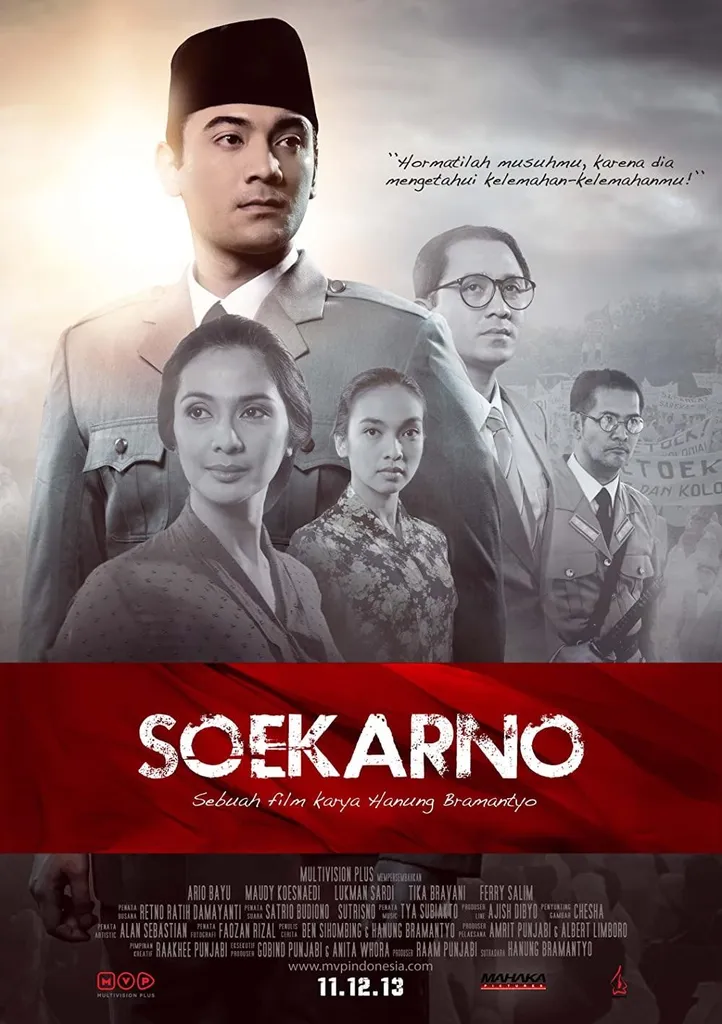Soekarno (2013) is a biographical drama film directed by Hanung Bramantyo, which portrays the life of Indonesia’s first president and proclamation hero, Soekarno. The film tells the story of Soekarno’s struggles and perseverance in fighting for Indonesia’s independence from Dutch-Colonialism, which later changed to Japanese-Colonialism. Together with Bung Hatta, Soekarno formulated the plan for the formation of the Indonesian state and became its leader.
The film covers almost all aspects of the life of the proclamation hero, including his love life, from his exile during the Dutch-Colonialism era to the reading of the independence proclamation. As an avid fan of history-themed movies and someone who is highly critical of the accuracy of facts presented, I was enthusiastic to watch this biographical film. In this article, I will provide a synopsis and review of this film, which is now available for replay on Netflix.
Synopsis
Year: 2013
Genre: Biography, History
Produced by: Dapur Film, MVP Pictures
Directed by: Hanung Bramantyo
Cast: Ario Bayu, Lukman Sardi, Maudy Koesnaedi
The story starts in Yogyakarta, 1929, when Soekarno was arrested by the Dutch Colonial government. The narrative then flashes back to the past, where young Soekarno was known as Koesno, who changed his name during a ‘ruwatan’ procession to Soekarno after frequently falling ill because he was inspired by the character Adipati Karno from the Mahabharata puppet show. As a teenager, young Soekarno lived in the house of HOS Tjokroaminoto and made friends with his future history-making colleagues, each with their own interpretations. There, he also learned the art of public speaking from the master.
In 1927, Soekarno founded the Indonesian National Party and became famous for his fiery speeches. After his arrest in Yogyakarta, he was moved to Banceuy prison in Bandung. His wife, Inggit Ganarsih, who lived in Bandung, often visited him. In 1938, after his famous “Indonesia Menggugat” plea, he and his family were exiled to Bengkulu.
In Bengkulu, Soekarno became a teacher at Muhammadiyah school and met Fatmawati, one of his students, who later became his wife. He was honored by the people of Bengkulu. However, he fell in love with Fatmawati, which disappointed and angered Inggit. In 1942, the Dutch surrendered to Japan. With his diplomatic skills, Soekarno tried to protect Bengkulu’s people from the brutality of the Japanese army, who did not hesitate to kill anyone who opposed them. Soekarno was able to gather rice according to the Japanese demand, among other things.
Due to his abilities, Soekarno was transferred by the Japanese government to Jakarta, where he met Moehammad Hatta (Bung Hatta) and Soetan Sjahrir. Bung Hatta bridged the rivalry between Bung Karno and Sjahrir. Together with Bung Hatta, Soekarno carried out various Japanese propaganda campaigns with the promise of independence. While the people who only saw the surface considered them traitors and cowards, in fact, Bung Karno and Bung Hatta devised their own plan for the formation of a free Indonesian state. Bung Karno also helped to recruit Indonesian youth to become members of the PETA (Defenders of the Homeland), which became the forerunner of the Indonesian National Army (TNI).
Bung Karno started to feel uneasy about the Japanese cruelties when he saw firsthand the Indonesian people being used as ‘romusha.’ With the help of Laksamana Maeda, they formed an organization to prepare for Indonesian independence according to the Japanese promise to him. There was commotion during the constitutional state formation meeting, which was eventually mediated by Bung Karno with his concept of Pancasila. Young people pressed Bung Karno and Bung Hatta to proclaim Indonesian independence as soon as possible since Japan had surrendered sovereignty to the Allies. They kidnapped the two leaders with the permission of the PETA chief, Gatot Mangkuprojo, who guaranteed their safety. Sjahrir, who knew about this, was furious and asked them to be returned. Once again, Laksamana Maeda helped these Indonesian leaders to prepare for their proclamation by inviting them all to his house to arrange and design the proclamation plans as soon as possible.
Bung Karno wrote the proclamation text concept from Bung Hatta, also assisted by Achmad Soebardjo. After finishing, the original text typed, and printed then distributed. Finally, on August 17, 1945, despite his illness, Bung Karno, together with Bung Hatta, proclaimed Indonesian independence. The following day, a government ministry cabinet was formed to run the government, and the Basic Law of the Country was enacted, with Soekarno as President and Moehammad Hatta as Vice President.
Conclusion
In conclusion, Soekarno (2013) is a must-watch film for all history enthusiasts, especially those interested in Indonesia’s road to independence. Hanung Bramantyo did an excellent job in directing this movie and portrayed Soekarno’s character and struggles accurately. Ario Bayu’s performance as Soekarno was excellent, and Lukman Sardi as Bung Hatta was equally impressive. Overall, the biographical film reflected the turmoil, hardship, and perseverance of the Indonesian people during their independence battle.




